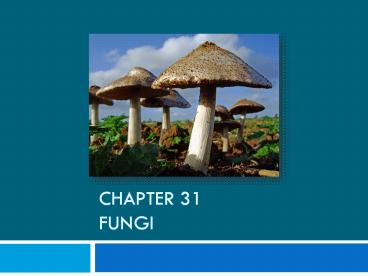Chapter 31 Fungi - PowerPoint PPT Presentation
1 / 23
Title: Chapter 31 Fungi
1
Chapter 31Fungi
2
Introduction
- Fungi are eukaryotes
- Nearly all multicellular (yeasts are unicellular)
- Distinguished from other kingdoms by
- Nutrition
- Structural organization
- Growth
- Reproduction
3
Absorptive nutrition enables fungi to live as
decomposers and symbionts
- Fungi are heterotrophs that acquire nutrients by
absorption - Secrete hydrolytic enzymes and acids to decompose
complex molecules into simpler ones that can be
absorbed - Specialized into three main types
- Saprobes- absorb nutrients from dead organic
material - Parasitic fungi-absorb nutrients from cells of
living hosts some are pathogenic - Mutualistic fungi-absorb nutrients from a host,
but reciprocate to benefit the host
4
Extensive surface area and rapid growth adapt
fungi for absorptive nutrition
- Hyphae makes up the mycelium and visible
structure we recognize as a mushroom - Except for yeast, hyphae are organized around and
within food source - Composed of tubular walls containing chitin
5
Fungal hyphae may be sepatate or asepatate
- Hyphae of septate fungi are divided into cells by
cross-walls called septa - Large pores allowing ribosomes, mitochondria,
nuclei flow from cell to cell - Hyphae of aseptate fungi lack cross walls
(coenocytic) - Parasitic fungi have modified hyphae called
haustoria, which penetrate the host tissue but
remain outside cell membrane
6
Fungi reproduce by releasing spores that are
produced either sexually or asexually
- Usually unicellular, haploid and of various
shapes/sizes - Asexual reproduction
- reproduce asexually by mitotic production of
haploid vegetative cells called spores - Spores are dispersed by wind and water creates
wide distribution of many species of fungi - Sexual reproduction
- results in greater diversity
7
Basic Cycle
8
Generalized life cycle of fungi
- Sexual Reproduction
- Plasmogamy fusion of cytoplasm of two parents
- Heterokaryotic mycelium contains nuclei from two
parents - Dikaryotic mycelium contains nuclei from two
parents, but each cell contain two nuclei - Karyogamy fusion of nuclei of two parents
9
Phylogeny of fungi
10
Chytrids might provide clues about fungal origins
- Originally places in Kingdom Protista
- Mainly aquatic
- Share many characteristics w/ fungi
- Absorptive nutrition
- Chitin cell-walls
- Hyphae
- enzymes/ metabolism
- Earliest fungi evolved from protists and
retained flagella
11
Zygomycetes
- Characterized by dikaryotic zygosporangia
- Mostly terrestrial-live in soil or decaying
material - Some from mycorrhizae, mutualistc associations
with plant roots - Hyphae are coenocytic-septa only found in
reproductive cells
12
Life cycle of zygomycete Rhizopus
stolonifer(common bread mold)
- Under favorable conditions, reproduces asexually
- Sporangia develop at tips of hyphae
- Mitosis produces hundred of haploid spores
- In unfavorable conditions of sexual reproduction
occurs - Mycelia of opposite mating types for gametangia
that contain several haploid nuclei walled off by
the septum - Plasmogamy of gameangia occurs ? dikaryotic
zygosporangium ? diploid nuclei immediately
undergoes meiosis producing haploid spores - Zygosporangium germinates sporangium which
releases recombined haploid spores
13
Cycle of common bread mold
14
Ascomycota
- Includes unicellular yeasts and complex
multicellular cup fungi - Hyphae are septate
- In asexual reproduction, tips of specialized
hyphae form conidia-chains of haploid asexual
spores - In sexual reproduction, haploid mycelia of
opposite mating strains fuse
15
Life cycle of ascomycete
16
Basidiomycota club fungi
- Important decomposers of wood/ plant material
- Include
- Mycorrhiza- forming mutualists
- Mushroom-forming fungi
- Plant parasites (rusts and smuts)
- Characterized by dikaryotic mycelium that
reproduced sexually by basidiocarps
17
Life cycle in detail
- Haploid basidiospores grow into short-lived
haploid mycelia under certain conditions
plasmogamy occurs - Resulting dikaryotic mycelium grows forming
mycorrhiza or mushrooms - Mushroom cap supports protects fills karyogamy
in the terminal, dikaryotic cells lining the
gills produces diploid basidia - Resulting basidium immediately undergoes meiosis
producing four haploid basidiospores - Asexual reproduction less common than ascomycetes
18
Molds
- Rapidly growing fungus w/ no sexual stages
- May develop into a sexual fungus, producing
zygosporangia, ascocarps, or basidiocarps - Molds w/ no known sexual stage are known as
Deuteromycota or imperfect fungi - Penicillium
- Flavor of blue cheese
19
Yeasts
- Unicellular reproduce
- Asexually by budding
- Sexually by producting asci or basidia
- Saccharomyces cerevisiae is most important
domesticated fungus - Baking brewing
- Model organism
- Can cause problems
- rhodotorula shower curtains
- Candida thrush
20
Lichens
- Symbiosis of algae w/ fungal hyphae
- The alga
- Provides fungus w/ food
- May fix nitrogen fixation
- Fungus provides good environment for growth
- Hyphal mass absorbs minerals and protects algae
- Produces compounds that
- Shield algae from sunlight
- Are toxic-prevents predation
21
Lichen reproduction
- Occurs as a combines unit or independently
- Fungi reproduces sexually (usually ascocarps)
- Algae reproduces asexually by cell division
- Symbiotic units reproduce asexually by
- Fragmentation of parent
- Formation of soredia small clusters of hyphae w/
embedded algae
22
Mycorrhizae
- Specific, mualistic association of plant roots
and fungi - Fungi increase absorptive surface of roots and
exchange soil minerals - Found in 95 of vascular plants
- Necessary for optimal plant growth
23
Ecological impact of fungi
- ecosys depend on fungi as decomposers
symbionts decompose food, wood, and plastic - Some fungi are pathogens (athletes foot,
ringworms) - Plants particularly susceptible
- Ergot-affects cereal crops causes gangrene,
hallucinations, and St. Anthonys fire - Many animals, including humans, eat fungi
- Truffles are underground ascocarps































